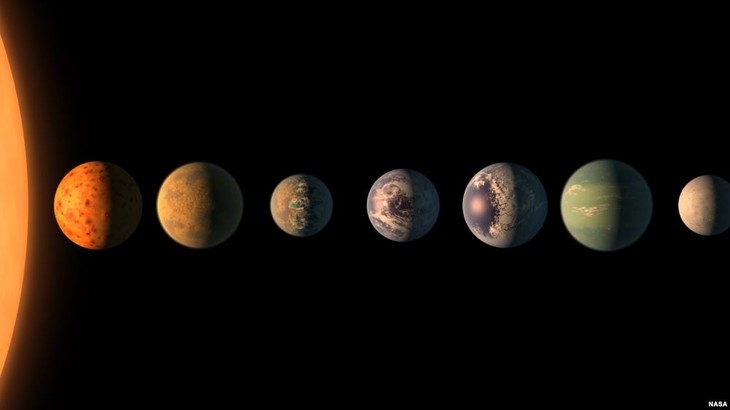New steps in finding life outside the Earth
Hong Van -
(VOVworld) - NASA has discovered 7 Earth-like planets orbiting a star just 40 light-years away. The discovery has shocked scientists and astronomers and promised possibility of finding life outside the Solar system.

This artist's concept shows what the TRAPPIST-1 planetary system may look like. (NASA) |
At a 1-hour press conference on February 22, NASA scientists said that for the first time ever, astronomers have discovered a system of seven Earth-sized planets orbiting around a single star. The planets were observed by NASA’s Spitzer Telescope. NASA says the planets are circling around a small, nearby dwarf star called TRAPPIST-1. The star is not hot like the sun. It is very cool, meaning liquid water could survive on planets orbiting close to it. Three of the 7 planets are directly in the star’s habitable zone, meaning water can mostly likely exist on the surface of them. They are called Trappist-1e, Trappist-1f, and Trappist-1g.

This illustration shows the possible surface of TRAPPIST-1f, one of the newly discovered planets in the TRAPPIST-1 system (NASA) |
Michael Gillon, an astronomer at the University of Liege in Belgium and the leader of an international team that has been observing Trappist-1 since 2010 says that this is the first time so many planets of this kind are found around the same star. All three exoplanets were about the size of Earth and in the so-called "Goldilocks Zone" where temperatures can hover between 0 and 100 degrees C—the ideal conditions for liquid water and, perhaps, life.
The new discovery set the record for the most habitable-zone planets found around a single star. Amaury Triaud, an astronomer at the University of Cambridge in England and another member of the research team, said that NASA discovery is a crucial step toward finding if there is life out there. Brice-Olivier Demory, professor at the University of Bern's Centre for Space and Habitability and one of the authors of a paper on the planets around TRAPPIST-1, said that looking for life elsewhere, this system is probably our best bet as of today.
The first step in finding life outside our own planet is to find a planet like our own: small, rocky, and at just the right distance from the star that liquid water could exist on its surface. That’s why an announcement from NASA is so exciting.
Hong Van